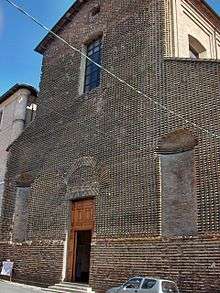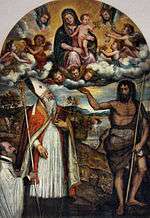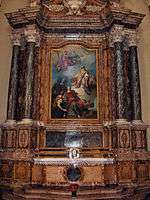San Francesco Saverio, Rimini
San Francesco Saverio also known as the Church of the Suffragio is a Baroque-style Roman Catholic church located in Piazza Ferrari #12 in Rimini, Italy.

History
The church was commissioned by the Jesuit order and built in 1721. The Jesuits previously had been housed in a site in Santa Maria a Mare. The design had been attributed to either Giovanni Francesco Buonamici or Francesco Garampi.[1][2]
The layout is modelled on the Gesù church in Rome. Adjacent to the church was once the Jesuit convent, which was for years a hospital, and now serves as Civic Museum. The facade remains incomplete in brick, but the interior is richly decorated, despite the suppression of the Jesuits by papal bull in 1773.[3]
Interior Decoration



An inventory in 1864 (also 1901) cited the following works in the church:[4]
- St Louis Gonzaga by Andrea Barbiani
- St Martin Bishop with St John the Baptist and the Virgin in Glory by Nicolo Frangipane
- Crucified Jesuit Martyrs in Japan (including the Blessed Paulo Miki) by Guido Cagnacci, right presbytery (still in situ)
- St Nicola and the Souls of Purgatory attributed to Visacci of Urbino, 1st altar left[5]
- St Antony (oval) by Giuseppe Soleri Brancaleoni, 1st chapel on left
- Departure from Calvary attributed to Zuccheri studio, 1st chapel on left
- Guardian Angel by Angelo Sarzetta, 1st chapel on left
- Virgin with Child, St Joseph and St Peter attributed to Antonio Puglieschi
- Marriage of the Madonna by Giovanni Battista Costa
- Deposition, by Giovanni Cesare Grazi, a copy of the work of Barocci located in Sinigallia
- Glory of St Ignatius by Rotari, altar by GF Buonamici, in transept[6]
- St Francis Xavier Preaching in the Indies, main altar, by Vincenzo Pisanelli
- St Emidius, Patron of Rimini (1788) by GS Brancaleoni, left transept, placed after earthquake of 1786[7]
- St Francis Borgia in Adoration of the Virgin painted by Pietro Rotari, in 1st altar right[8]
- Annunciation, by Tuscan painter, left presbytery
- St Stanislao by Giovanni Maria delle Piane (Molinaretto), copy of GG dal Sole painting, sacristy.
- St Michael Arcangelo by Sarzetto, sacristy
- Bambino che schiaccia il Drago, by Giovanni Francesco Nagli, sacristy
References
- Guida del forestiere nella città di Rimini, by Luigi Tonini, 1864, page 23.
- La patria; geografia dell' Italia: pte. 2. Provincie di Ravenna, Ferrara, Forli', Luigi Borsari, 1901, page 279 and 281.
- Rimini Turismo, entry.
- Tonini (1864) and Borsari (1901).
- Still in situ, Rimini Turismo
- Still in situ, Rimini Turismo
- Still in situ, Rimini Turismo
- Still in church, Rimini Turismo